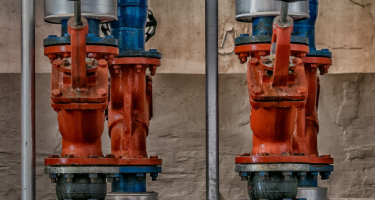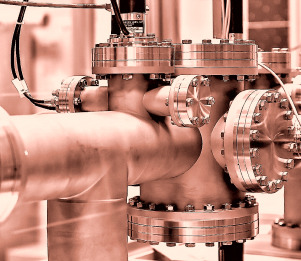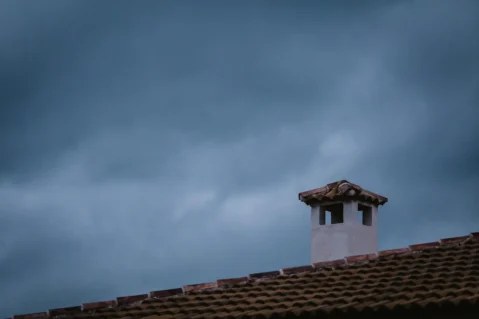
October 2, 2025 /
Chimney
The chimney is one of the key elements of the heating system, directly affecting its safety and durability. Old brick constructions cannot handle modern boilers and quickly deteriorate under the influence of moisture and acids. They are being replaced by stainless steel and chamotte solutions, resistant to high temperatures and condensate. In this article, we explain the differences between single-wall and double-wall chimneys and when it is better to use coaxial systems. You will learn how to correctly choose the shape and installation location to avoid mistakes. Such an overview will help you select a chimney that will last for decades and ensure stable boiler operation.
The first piece of advice is that the requirements for a chimney used with modern heating boilers differ greatly from those in the past. Paradoxically, more advanced modern equipment places much stricter demands on chimneys.
The fact is that old boilers worked without automatic regulation and with high flue gas temperatures. As a result, chimneys almost never cooled down, and the gases did not drop below the dew point — meaning they did not damage the chimney.
Modern boilers are efficient: their power is regulated depending on the heating needs of the premises, and therefore they do not run continuously but only when the room temperature falls below the setpoint. Thus, there are periods when the boiler is off, and the chimney cools down. In addition, new boilers have reduced flue gas temperatures.
The walls of a traditional chimney connected to a modern boiler rarely heat up above the dew point, which leads to constant condensation. This, in turn, damages the chimney. Old brick chimneys are especially vulnerable under such conditions. An additional problem is sulfur contained in the fuel and, consequently, in the flue gases. Water vapor, combining with sulfur oxides, forms sulfuric acid, which penetrates chimney walls and destroys them.
It is obvious that modern boilers require modern chimneys.
Chimneys recommended for use today
Old brick chimneys are being replaced by chimneys made of stainless steel and chamotte.
The most common are stainless steel chimneys. The main components of stainless steel are chromium and nickel, but the steel used for modern chimneys also contains other elements.
Examples:
- Molybdenum — increases steel resistance at high temperatures, improves creep strength. In amounts of 1.5–3%, it increases resistance to sulfur and chlorine compounds as well as to hydrogen under pressure and high temperatures.
- Titanium — forms carbide by binding excess carbon in steel.
The condition of the surface is also very important: it must be clean and smooth.
As for the chimney cross-section shape, the round form is preferable to square or rectangular, since corners create turbulence that hinders smoke removal and contributes to soot formation.
Modern stainless steel chimneys come in two types:
- Single-wall — a simple 0.5–0.6 mm thick pipe without insulation. Usually used indoors or inside brick channels.
- Double-wall — consist of two layers of stainless steel with insulation in between. Such a chimney can be used both inside and outside the building.
Where it is better to install a chimney
Considering possible noise from boiler operation, it is not recommended to route the chimney through bedrooms or other quiet spaces. Most often, chimneys are routed through kitchens, corridors, bathrooms, and utility rooms.
Sections of the chimney exposed to the outside environment must be insulated. The top cut of the chimney must rise:
- 0.5 m above the roof ridge;
- 1 m above flat roofs (with slope less than 30°).
This helps avoid attic smoke contamination.
With some modern boilers, instead of a traditional tall chimney, a short coaxial one can be used. For this, the boiler must have a built-in fan (forced draft). Usually, these are modern wall-mounted models from European manufacturers.
In a coaxial chimney:
- the inner pipe expels flue gases outside with the fan;
- the outer pipe supplies combustion air.
A coaxial chimney can be horizontal or vertical. A combined option is also possible: air intake via a horizontal coaxial section, while flue gases are discharged through a traditional vertical chimney.
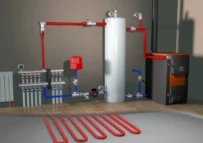
Heating system automation
How automation maintains comfortable temperature and protects the heating system
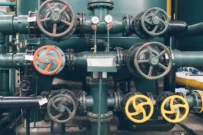
Room for gas equipment
Standards for boiler rooms: from air inlets to minimum façade distances
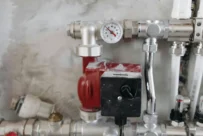
Gas equipment – part 3
Efficient heating: boiler capacity calculation and an overview of alternative heaters
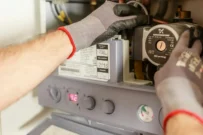
Gas equipment – part 2
Condensing boilers: how they work, efficiency, and when they pay off.
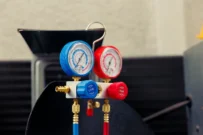
Gas equipment – part 1
Modern gas boilers: floor-standing and wall-mounted solutions for houses and apartments
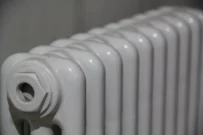
What kinds of heating devices are there?
Radiators, convectors, and underfloor heating: comparing design, heat output, and areas of application.

